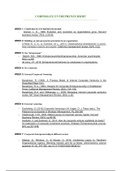CORPORATE ENTREPRENEURSHIP
———————————————————————————————————————————
WEEK 1: CORPORATE ENTREPRENEURSHIP
- Greiner, L. E., 1998. Evolution and revolution as organizations grow. Harvard
business review, 76(3), p.55-64.
WEEK 2: Building an entrepreneurial orientation in an organization
- O'Reilly III, C. A., & Tushman, M. L. (2011). Organizational ambidexterity in action:
How managers explore and exploit. California management review, 53(4), 5-22.
WEEK 3: the “intrapreneur”
- Hisrich, R.D., 1990. Entrepreneurship/intrapreneurship. American psychologist,
45(2), p.209
- de Jong, J.P., 2016. Entrepreneurial behavior by employees in organizations.
WEEK 4: No materials
WEEK 5: Internal Corporate Venturing
- Burgelman, R. (1983). A Process Model of Internal Corporate Venturing in the
Diversified Major Firm.
- Burgelman, R. A. (1984). Designs for Corporate Entrepreneurship in Established
Firms. California Management Review, 26(3), 154–166.
- Burgelman, R.A. and Välikangas, L., 2005. Managing internal corporate venturing
cycles. MIT Sloan Management Review, 46(4), p.26.
WEEK 6: External venturing
- Dushnitsky, G. (2018) Corporate Venturing in M. Augier, D. J. Teece (eds.), The
Palgrave Encyclopedia of Strategic Management. Pg 256-260
- Chesbrough, H.W., 2002. Making sense of corporate venture capital. Harvard
Business Review, 80(3), pp.90-99.
- Souitaris, V. and Zerbinati, S., 2014. How do corporate venture capitalists do deals?
An exploration of corporate investment practices. Strategic Entrepreneurship Journal,
8(4), pp.321-348.
WEEK 7: Corporate Entrepreneurship in different sectors
- Dalpiaz, E., Rindova, V., & Ravasi, D. 2016. Combining Logics to Transform
Organizational Agency: Blending Industry and Art at Alessi. Administrative science
quarterly, 61 (3), 347-392. doi:10.1177/0001839216636103
,Article Summary
WEEK 1: Greiner, L. E., 1998. Evolution and revolution as organizations grow. Harvard
business review, 76(3), p.55-64.
Problems in certain companies are rooted more in past decisions than in present events or
market dynamics. Management often overlooks such critical developmental questions as,
Where has our organization been? Where is it now? and What do the answers to these
questions mean for where it is going? Instead, management focuses towards the future. We
can identify a series of developmental phases through which companies tend to pass as
they grow, each begins with a period of evolution with growth and stability, and ends with a
revolutionary period of substantial turmoil and change.
Mostly empirical research is done on organizational development (no models). When
analyzing the research, 5 key dimensions of an organization emerge:
1. Age
2. Size
3. Stages of evolution
4. Stages of revolution
5. Growth rate of its industry
5 specific phases of evolution and revolution: ‘The Five Phases of Growth’
Between each phase there is a period of evolution (growth) and a period of revolution (crisis)
1.Creativity Age: Young Size: Small
*crisis of leadership*
2. Direction
*crisis of autonomy*
3. Delegation ⇩⇩ ⇩⇩
*crisis of control*
4. Coordination
*red tape crisis*
5. Collaboration Age: Mature Size: Large
Companies in faster-growing industries tend to experience all 5 phases more rapidly,
whereas those in slower-growing industries encounter only 2 or 3 phases over many years.
Many large U.S. companies are now in phase 5 evolutionary stage, but what will be the
revolution in response? It will center around the psychological saturation of employees who
grow emotionally and physically exhausted from the intensity of teamwork and the heavy
pressure for innovative solutions. Greiner thinks it will be solved again through new
structures and programs that allow employees to periodically rest, reflect and revitalize
themselves. Companies may have a dual structure: habit structure and a reflective
structure.
A habit structure for getting the daily work done and a reflective structure for stimulating new
perspective and personal enrichment. Employees could move back and forth between the
two structures as their energies dissipate and are refueled.
, Some explicit guidelines for managers for growing organizations:
1. Know where you are in the developmental sequence
2. Recognize the limited range of solutions
3. Realize that solutions breed new problems
WEEK 2: O'Reilly III, C. A., & Tushman, M. L. (2011). Organizational ambidexterity in action:
How managers explore and exploit. California management review, 53(4), 5-22.
James March: “The basic problem confronting an organization is to engage in sufficient
exploitation to ensure its current viability and, at the same time, devote enough energy to
exploration to ensure its future viability.”
Evolutionary engineering: the use of organizational experience and memory to strengthen
the exploitation and exploration process and to adapt to changed environmental conditions.
Dynamic capabilities underpin the organization’s ability to maintain ecological fitness and to
reconfigure existing assets and develop the new skills needed to address emerging threats
and opportunities.
Two critical tasks to achieve ambidexterity:
1. Sense changes in competitive environment (shifts in technology, competition,
customers, regulation)
2. Seize opportunities (/act on threats)
Ambidexterity is more likely to be successful with these five conditions:
1. A compelling strategic intent that intellectually justifies the importance of both
exploration and exploitation.
2. An articulation of a common vision and values that provide for a common identity
across the exploitative and exploratory units.
3. A senior team that explicitly owns the unit’s strategy of exploration and
exploitation; there is a common-fate reward system; and the strategy is
communicated relentlessly.
4. Separate but aligned organizational architectures (subunits) (business models,
structure, incentives, metrics, and cultures) for the exploratory and exploitative
units and targeted integration at both senior and tactical levels to properly
leverage organizational assets.
5. The ability of the senior leadership to tolerate and resolve the tensions arising
from separate alignments.
(Senior managers and key informants in each firm were interviewed and asked to describe in
detail how they attempted to simultaneously explore and exploit.)
The most-successful ambidextrous designs had leaders who developed a clear vision and
common identity (condition 2), built senior teams that were committed to the ambidextrous
strategy and were incented to both explore and exploit (condition 3), employed distinct and
aligned subunits to focus on either exploration or exploitation (condition 4), and built teams






